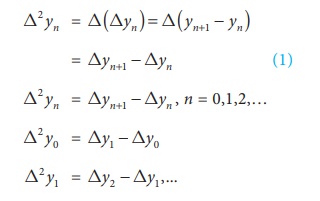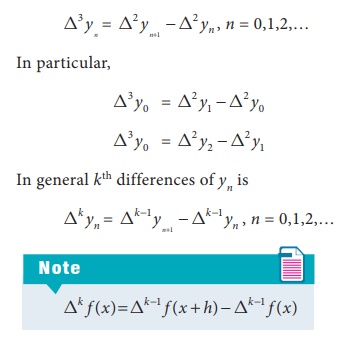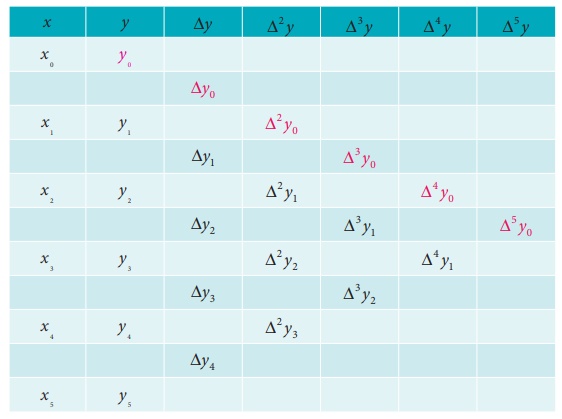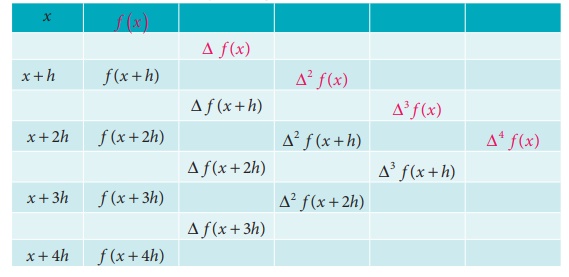Finite Differences | Numerical Methods - Forward Difference Operator(∆) | 12th Business Maths and Statistics : Chapter 5 : Numerical Methods
Chapter: 12th Business Maths and Statistics : Chapter 5 : Numerical Methods
Forward Difference Operator(∆)
Forward Difference Operator(∆ ):
Let y = f(x) be a given function of x.
Let y 0 , y1 , y 2 , ….. ,
yn be the values of y at = x 0 , x1
, x 2 ,•,
xn respectively. Then y1 − y 0 ,
y 2 −
y1, y 3 −
y 2 , …,
y n −
yn−1 are called the first (forward) differences of the function y. They are denoted by Δy 0 , Δy1 , Δy 2 ,..., Δyn−1 respectively.
(i.e) Δy 0 =
y1 −
y 0 , Δy1 = y 2 − y1, Δy 2 = y3 − y 2
,..., Δyn −1 = y n
− yn−1
In general, Δy n =
yn+1 − y n
, n = 0,1,2,3,...
The symbol Δ
is called the forward difference operator and pronounced as delta.
The forward difference operator ∆ can also be defined as Df ( x) = f ( x + h ) − f ( x), h is the equal
interval of spacing.
Proof of these properties are not included in our syllabus:
Properties of the operator Δ :
Property 1: If c is a constant then Δc = 0
Proof: Let f (x) =
c
∴ f ( x + h ) = c (where ‘h’ is the
interval of difference)
Δf ( x) = f ( x + h ) − f ( x)
Δc = c − c = 0
Property 2: Δ is distributive i.e. Δ ( f (x) + g (x)) = Δ f (x) + Δ g (x)
Proof: Δ[f (x) + g (x)] = [f (x + h ) + g(x + h) ] – [f (x)+ g (x)]
= f (x + h ) + g(x + h) − f (x) − g (x)
= f (x + h ) − f (x )+ g(x + h) − g (x)
= Δ f (x) + Δ g (x)
Similarly we can show that Δ [f ( x) − g ( x)] = f (x) − Δ [g ( x)]
In general, Δ[ f1 (x) + f 2 (x)...... + f n (x) ] = Δ f1 (x)+ Δ f 2 (x) + .... + Δ f n (x)
Property 3: If c is a constant then Δ c f ( x ) = c Δ f ( x)
Proof: Δ [c f (x)]
= c f ( x + h) − c f ( x)
= c [ f (x + h) −
f (x)]
= c Δ f (x)
Results without proof
1.
If m and n are positive integers then Δ m
. Δ n f (x) = Δ m +n f (x)
2.
Δ[ f (x) g (x) ] = f (x) g (x) + g (x) Δ f (x)
3.

The differences of the first differences denoted by Δ2y0,
Δ2y1, …., Δ2yn, are called second differences, where

Similarly the differences of second differences are called third differences.

It is convenient to represent the above differences in a table as
shown below.
Forward Difference Table for y :

The forward difference table for f(x) is given below.

Related Topics